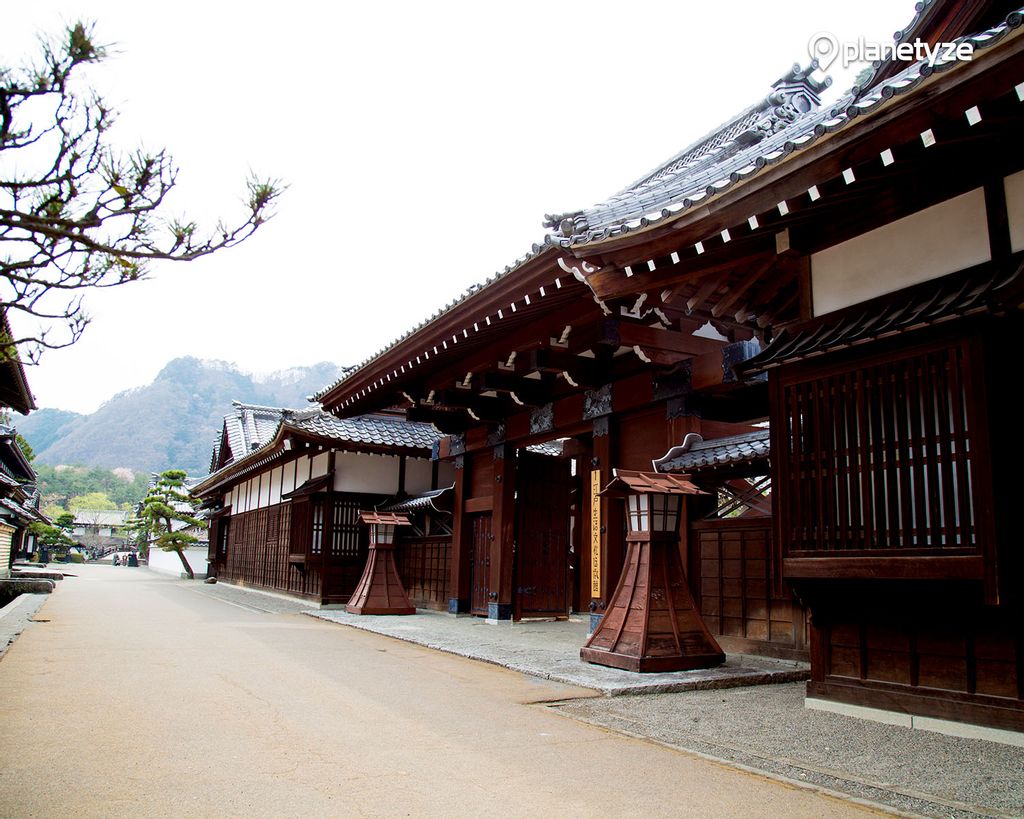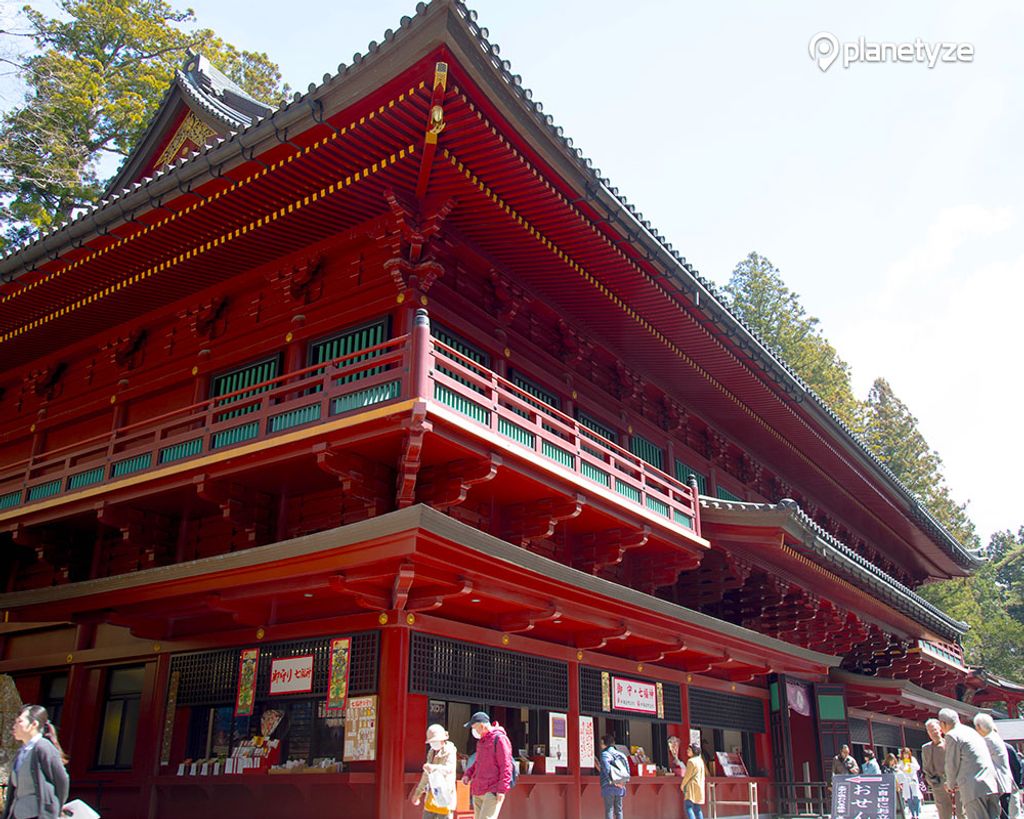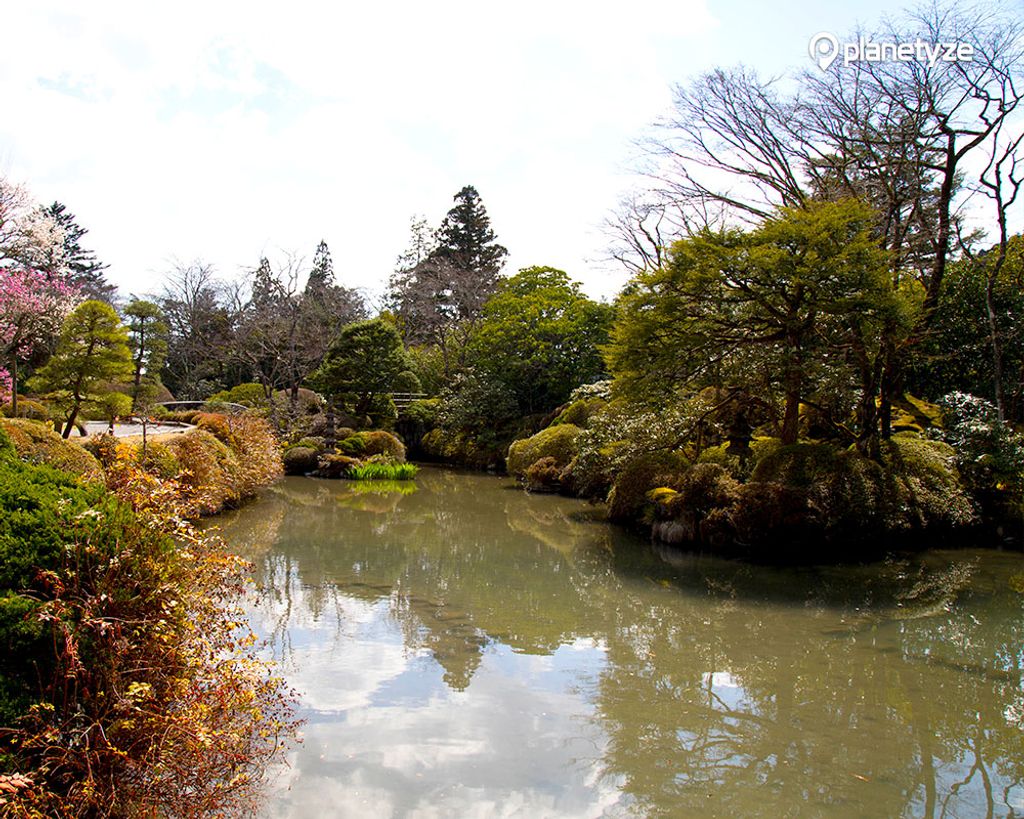Nikko is almost straight to North from Tokyo for about two hours. If you are traveling around Japan or just staying in Tokyo you might want to do a little one or two day trip to the beautiful mountain area of Nikko. You can find many unique and beautiful sights like the Shinkyo bridge, Toshugu shrine or the interesting theme park Edo wonderland where you can feel the spirit of the samurai and learn the ways of the ninja. Here are few Sights in Nikko that you can see in just couple of days.
Walk across a bridge made of snakes (The Shinkyo bridge)
The discovery of Nikko happened in the 8th century during the Nara Era. When Mt. Nikko was first explored, steep cliffs and the rough waters of the Daiya River were major obstacles. The bridge’s legend began when the monk Shodo Shoin prayed to the gods there and the god Jinja-Daiou appeared, with two snakes transforming into a bridge which he could cross. Only used in special cases for events or when the shogun was passing through, ordinary people traveled over Nikko Bridge downstream. Although Shinkyo Bridge can be traversed for a fee. Among the important events is the annual cleaning. Every year in December, Shinto priests in Heian Era kariginu clothing and eboshi headgear along with shrine maidens in white clothing and red skirts use 4m bamboo poles and sweep away a year’s worth of dust as a custom in preparation for the New Year. Approximately 3m poles sweep the dust off the 28m-long bridge so that it is not damaged. By around noon, the brilliance of the vermillion increases and the bridge’s elegant appearance returns.
Late October to early November is the best time to see the autumn colors at Shinkyo Bridge. With the blue of the river, the vermilion of the bridge and the gold of the trees, the scene comes to resemble a painting. In particular, the time of the soft light in the morning creates a divine mountain, a landscape that is befitting of Nikko. At night, the area is illuminated. This occurs from late October to early November for a period limited to 3 days. The two shrines and one temple of Tosho-gu, Rinno-ji and Futara-Arayama are lit up along with Shinkyo Bridge. The collaboration between World Heritage Sites and autumn leaves being illuminated takes you into a fantastic world. It is a precious event to be appreciated.
Business Hours:
April – September: 8:00 to 17:00
October - mid-November: 8:00 to 16:00
Mid - November – March: 9:00 to 16:00
Admission (to walk over the bridge):
Adult: ¥ 500/High school student: ¥ 300/Child: ¥ 100
Address:
Nikko Futarasann Shrine, Nikko 321-1431, Tochigi Prefecture
Learn how to become a ninja (Edo Wonderland)
The borders and town streets, the downtown area and samurai residences, everything is built as structures from the Edo Era. The staff boost up the atmosphere. Everyone changes completely into samurai, ninja and Edo town residents, and fights and detective stories play out for real along the roadsides. You will enjoy yourselves no matter when and where you are. There are few places to get warm, and from around 2 p.m. in winter, the cold intensifies so please dress up for the weather. You can masquerade yourself as a citizen of the Edo Era such as a ninja, samurai, feudal lord, princess, artisan or female swordsperson, etc. for a day. The staff will even address you as that transformed character. You will learn 5 disciplines (wall-climbing, crawling above ceilings, navigating through traps, underground infiltration, shuriken throwing). Experience the arts of protecting yourself and deception. This is a huge maze. There are also tricks that aren’t present in the usual mazes. It is exceptionally hard but emergency exits are available. You will have plenty of Edo Era amusement such as ninja, sword battles, water tricks, and courtesan dances. Spectacular performances will be right in front of your eyes.
Business Hours:
20 March - 30 November: 9:00 to 17:00 (Closed on Wednesdays)
1 December - 19 March: 9:30 to 16:00 (Closed on Wednesdays)
Admission:
Adult: ¥ 4,700 /Child: ¥ 2,400
Adress:
Edo Wonderland, 470-2 Karakura Nikko-shi Tochigi
Take a boat across a massive lake (Lake Chuzenji)
Popular with foreigners charmed by Lake Chuzenji during the Meiji Era for its cool climate, embassy villas for the United States and European countries were built one after another there. As a summer resort, you can get a glimpse of Western history. There are traces of those buildings at the lake and the surrounding vicinity. The Italian Embassy Villa Memorial Park was built in 1928 and up to 1997, was used by successive generations of ambassadors and their families. Afterwards, it was donated to Tochigi Prefecture and reconstructed, and was opened to the public as a free park in 2000. Note the regional cedar used by the celebrated American architect Antonin Raymond. It is a unique construction utilizing the cedar bark for the entire structure from exterior to interior which is splendidly harmonized with the rich nature.The villa is 2 stories high and was designed meticulously so that you can see the lake from every room. The fireplace is surrounded by Western-style furnishings so you can spend an elegant time there. Going down to the lake, there is a pier and from there, you can view the scene of Mt. Nantai.
The villa residence has been remodeled to become an international summer resort museum. In contrast with the main embassy residence, the forest view from the windows of this residence is outstanding. Photographic panels and videos of Lake Chuzenji that has become an international meeting place are introduced.
Nikko Shinko Church is a Tangible Cultural Property designated by Tochigi Prefecture. Many foreign visitors who came to spend time at Nikko as a summer resort wanted to have a church established there and so it was built. James M. Gardiner, the architect behind the church’s stately Gothic stone construction, and his wife are buried there. It has a unique atmosphere with andesite from the nearby Daiya River and local Kanuma stone being used. The stained glass noticeably stands out. Aside from worship services and special events, you can tour the church free of charge. Meiji-no-Yakata is a nationally designated Tangible Cultural Property. It was once a villa built for an American trader, but it is now a restaurant specializing in yoshoku, Western-influenced Japanese cuisine. The building has a Georgian design which was popular in 18th-century England. The rice omelet and cheesecake are famous. The restaurant is always crowded so while waiting you can take a stroll at the same site through the garden.
Address: Lake Chūzenji, Chugushi Nikko-shi Tochigi
Admission (boat rides): Starting from around ¥ 1,000
Explore the origin of the Three Wise Monkeys (Toshogu Shrine)
Toshogu enshrines Ieyasu Tokugawa, the first Shogun (military governor) of the Edo Shogunate (government), and it is also the location of Ieyasu’s grave. It was originally a simple and plain structure but the third Shogun Iemitsu built a host of brilliant shrines. This section introduces the must-see spots of Toshogu shrine. When the temple bell of Rinnoji is sounded at 8 o’clock in the morning, the gate of Toshogu shrine is opened. The shrine begins to get crowded from around 9 o’clock so you would probably want to enter the shrine immediately after the gate is opened. One of the highlights of Toshogu shrine is the animal related ornamentations. What must be mentioned first is the holly stable for the horses that serve the Gods on which the “Three Wise Monkeys” are depicted. The stable features eight pictures depicting the tale of a monkey from when it is born until it becomes a mother. Among these, the famous three monkeys symbolizing “see no evil, hear no evil, and speak no evil (Mi-zaru, Kika-zaru, and Iwa-zaru, a pun between saru or vocalized zaru “monkey” and archaic -zaru “a negative verb conjugation”)” are depicted on the second picture. The meaning behind this picture is to prevent the infant monkey from seeing, hearing or talking about the wickedness of the secular society. Another highlight is the “Sleeping Cat” at the top of Sakashita gate, the entrance to the grave of Ieyasu. This artwork was carved by the grate craftsman of the Edo period (1603 – 1868), Jingoro Hidari. Although it is not well known, sparrows are depicted on the back of the cat. It is said that this design–sparrows playing right next to their predator–symbolizes Ieyasu’s wish to create a peaceful world free of wars and conflicts.
Yomeimon gate, the entrance to the main hall, is the symbol of Toshogu shrine. Dragons are depicted all over the gate. Some of these dragons are portrayed with unconventional characteristics such as hoofs and nostrils, and there are even ones that are depicted without whiskers. According to a Chinese tradition, dragons are a transformed form of carps; meaning, one can ultimately become a grand dragon by practicing daily. There are four columns at the back of the gate. Interestingly, patterns are depicted upside down on the second column from the right. Since it is said that buildings begin to demise from the instant they are completed, one column was purposely left in an incomplete state in hopes that the building will not collapse.
Business Hours:
April 1 - October 31: 8:00 to 17:00
November 1 - March 31: 8:00 to 16:00
(last entrance 30 min before closing)
Toshuga Shrine Admission = Adult: ¥ 1,300/Child: ¥ 450
Treasure House admission = Adult: ¥ 500/High school Students ¥ 300/Child: ¥ 200
Museum of Art Admission = Adult: ¥ 500/High school Students ¥ 300/Child: ¥ 200
Address:
Nikkō Tōshō-gū, 2301 Sannai Nikko-shi Tochigi
Visit an incredible waterfall (Kegon Falls)
Kegon Falls is located by the outlet for Lake Chuzenji which was formed from the eruption of Mt. Nantai. The underground water from the steep cliffs flows out forming 12 small waterfalls that are wrapped into the main waterfall which creates a unique scene. Monk Shodo Shonin has been credited as the first discoverer of Nikko, and the name of the waterfall is derived from the sacred book of Buddhism, “Kegon Kyo” (Avatamska Sutra) of the Tendai sect. A waterfall with a long drop in elevation needs a certain amount of water. Around the waterfall basin, the fairly high water pressure flying out feels like a driving rain. The 4.5m-deep basin has a mysterious atmosphere. Designated as a National Place of Scenic Beauty, Kegon Falls has been recognized by many organizations for the wonder of its scenery, including its selection as one of Japan’s 100 geological features. There are observation areas at the top and bottom of the falls. An elevator at the base of the falls goes down 100 m, and through an underground path, you can reach the waterfall basin. Spanning 3 floors, you can freely come and go. Following the rainy season and typhoons, the amount of water rises and you can witness a lively show of huge sound and water spray.
From Akechi-Daira Observation Platform, you can take in the entire view of the waterfall flowing from Lake Chuzenji. Taking 35 minutes by bus from Tobu-Nikko Station, there is the ropeway going up near the end of the No. 2 Iroha slope that will take you from Akechi-Daira Station to Akechi-Daira Observation Platform (a 3-minute ride). You can feel the grand scale of the sight that cannot be seen from the bottom.
Kegon Falls does not freeze over. However, in January and February, the 12 small surrounding waterfalls do. Due to this, the waterfall as a whole takes on a blue color and as a result, the effect has been called blue ice. The spring and fall are fine, but the waterfall of snow and ice also leaves a considerably deep impression.
Business Hours:
March - November: 8:00 to 17:00
December - February: 9:00 to 16:30
Admission (elevator to observatory deck):
Adult: ¥ 550/Child: ¥ 330
Address:
2479-2 Chugushi, Nikko 321-1661, Tochigi Prefecture
Eastern Japans biggest wooden building and the beauty of the gardens (Rinnoji Temple)
Rinnoji Temple was made around 1200 years ago the monk named Shodo chose the spot because it was near the mountains in isolation making it a peaceful area, that attracted more and more monks over to the temple. This amazing sight in Nikko has 15 temples in it and one of these is the biggest wooden building in eastern Japan, unfortunately the building is still under great repairs and won’t be ready till the 2019. You can still get in to the building to see the great three Buddhist statues of Amida, Kannon with thousand arms and Kannon with a horse head. It should not come as a surprise that the area is one of UNESCO’s word heritage sites. The large Japanese style garden named Shōyō-en Garden is also a sight to see, just walking there and enjoying the scent of the nature and sight of it. Enjoy the sight of the carps in the ponds. There are lot of different kind of ceremonies and events held at the temples so if you are about to head there it is good to check if there might be one going on when you are there.
Business Hours:
November to March: 8:00 – 16:00
April to October: 8:00 – 17:00
Admission:
Rinnoji Temple = Adult: ¥ 900/Child: ¥ 400
Treasure hall and Garden ticket = Adult: ¥ 300/Child: ¥ 100
Address:
Rinnoji, 2300 Sannai Nikko-shi Tochigi



/filters:quality(80)/fit-in/800x800/planetyze/guidebook/62/2214.jpg)
/filters:quality(80)/fit-in/800x800/planetyze/guidebook/148/8499.jpg)
/filters:quality(80)/fit-in/800x800/planetyze/guidebook/159/8554.jpg)
/filters:quality(80)/fit-in/800x800/planetyze/guidebook/170/8537.jpg)
/filters:quality(80)/fit-in/800x800/planetyze/guidebook/160/12282.jpg)
/filters:quality(80)/fit-in/800x800/planetyze/guidebook/60/8509.jpg)